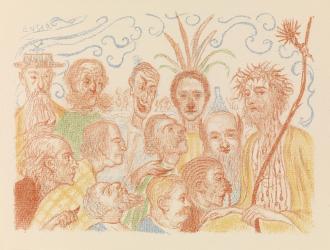This archived website ‘James Ensor. An online museum.’ is temporarily not being updated. Certain functionality (e.g. specific searches in the collection) may no longer be available. News updates about James Ensor will appear on vlaamsekunstcollectie.be. Questions about this website? Please contact us at info@vlaamsekunstcollectie.be.
KMSKA buys new works of Ensor
Is Ensor's artistic production dating after 1893 truly of a lesser value than earlier work? Quite a few experts appear to think so, but not everyone holds this opinion. One could also say that Ensor's later work is not properly studied. The KMSKA purchased Scènes de la vie du Christ (an album with 32 lithographs from after 1900) and can in this way do something about the lacuna in Ensor research.
It contains lithographs in four colours: red, yellow, green and blue. Most likely these are the very first true reproductions of the coloured drawings that Ensor had given to a specialist in the making of lithographs.
The majority of the prints are not dated. A large number were probably already drawn in 1913. Perhaps the plan was to make an album on the life of Christ thwarted by WWI and then taken up again after its course was done.
Ensor had previously occupied himself with the depiction of the important moments from the New Testament. Some of the images he has used again in altered forms for the album. Thus, we have at least four variations of the image of Christ Calms the Storm: an etching from 1886, a painting from 1891 (Mu.Zee, Ostend), a painting from around 1913 (on loan to the Museum of Elsene) and the print from the album of about the same time. From some episodes, such as The Silver Pieces of Caesar, The Mockery of Christ and the Calvary, he lays aside the older presentations and makes an entirely new composition. Moreover, a few prints from the album inspired him over the years to the making of new paintings. The Miraculous Catch of Fish (1917?) is an example of that.
The art of religious painting was early on in the 19th Century a genre that had become of lesser importance, but in the last decades of the century experienced a revival. This goes along with the turn away from the symbolists from the banal and their search for enigmatic and sublime images. It is as if Ensor mocked the trend in a large number of the amusing, burlesque and even grotesque Scenes from the Life of Christ.
Info: Scènes de la vie du Christ, album with 32 lithographs on paper (220 x 280 mm), nr. 264 / 275, signed on the title page: James Ensor. Printed by J. E. Goossens, Brussels, 1 June 1921, published by Galerie Giroux, Brussels. Inv. nrs. 3469/1-32.







